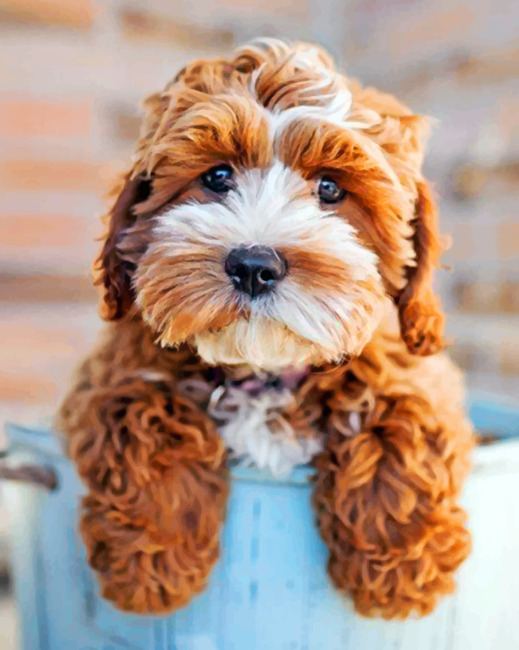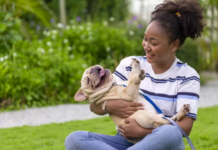Last Updated on September 9, 2021 by Fumipets
The Cockapoo, a beautiful little dog with the attitude of a giant clown, is perhaps the earliest of the “designer dogs” (non-purebred dog breeds), dating back to the 1960s rather than just a few years ago.
Despite their unfortunate reputation as a designer breed, these hybrid dogs can be found in shelters and rescues, so adopt one if you can!
Breeders blended the Cocker Spaniel and Poodle breeds to create a totally people-oriented hybrid that’s easy to teach, doesn’t shed much, forgives fast, and is so loving that you’ll never feel lonely. In fact, for a moment’s peace and quiet, you may have to close the restroom door.
Your hybrid companion will also like racing around an agility course, doing tricks for visitors, being stroked as a therapy dog, or just sitting on your lap. By the way, your lap is theirs.

What makes Cockapoos Special
The Cockapoo, a cross between a Poodle and a Cocker Spaniel, set the standard for planned hybrids. Also known as the Cockapoodle, Cockerpoo, or Cock-a-Poo, and he’s an adorably cute little dog with a face that could melt a stone’s heart.
He’s kind and welcomes everyone, even the elderly, children, and other pets. He’s also a good size, tiny enough to snuggle but large enough to play with larger dogs. Cockapoos have an exuberant enthusiasm for life that rubs off on everyone around them, that vital joie de vivre turns every day into a party. These guys are just happy to be alive.
Still, what makes a Cockapoo more appealing than a Cocker Spaniel or a Poodle? It’s because the Cockapoo embodies two ideals: first, what the Cocker Spaniel used to be across the board — a sweet and stable temperament — before the breed’s popularity soared in the wake of Lady and the Tramp; and second, the Poodle’s orientation to people smooths out the Cockers’ orientation to their noses when they’re out in the field.
Furthermore, Cockapoos do not need the same degree of grooming as Poodles, and people do not react as adversely to a Poodle’s lavish grooming style for conformation showing as they do to a Cockapoo’s.
Of course, there’s a world of difference between a deliberate mating of well chosen Cocker Spaniels and Poodles and a Poodle mix that is simply referred to as a Cockapoo since no one knows what his true history is.
The genuine Cockapoo was bred with the intention of producing a healthy, hypoallergenic dog with a pleasant disposition. Cockapoo breeders believe that the health and temperament of their dogs are much more important than their looks, and they continue to strive for that (but nevertheless, the Cockapoo tends to be an adorable-looking fellow). There aren’t many, if any, debates regarding head form and height among these breeders.
When the cross is done correctly, the Poodle’s intellect and spirit are combined with the Cocker’s hardiness and field spirit. Of course, if the cross fails, you’ll end up with a subservient, urinating fear-biter, but that may happen to any mixed breed or purebred with sad genes.
The Cocker Spaniel used to produce the Cockapoo is often an American Cocker Spaniel, although some are the offspring of Poodles and English Cocker Spaniels, the latter of which is sometimes referred to as a Spoodle. Over the past decade, efforts have been undertaken to clearly differentiate Cockapoos and Spoodles into two distinct hybrids, with some success. If you’re concerned about the kind of Cocker involved, make sure to inquire.
But none of that matters to a Cockapoo fan who just wants to spend time with a nice, adorable, devoted dog that isn’t quite the barnacle that a Toy Poodle may be, and who started as a glint in a Cocker Spaniel’s eye with a wonderful, even temperament.

Things you should know before getting a cockapoo
Cockapoos aren’t renowned for barking. Some, on the other hand, may bark if they notice someone approaching their home or if they are left alone for an extended length of time.
The Cockapoo is a nonshedding dog with very little canine odour on its skin and hair. He has to be brushed on a daily basis, and his hair will need to be cut and clipped on a regular basis.
Cockapoos are generally beneficial for allergy sufferers since they generate less dander and hair.
Cockapoos were created to be companion dogs and are often sociable and cheerful. They get along nicely with other dogs, pets, and children; however, older, more thoughtful youngsters are preferred.
Although the Standard or Maxi Cockapoo does not adjust to apartment living as well as his smaller counterparts, he may perform well if properly exercised. A home with a modest, fenced yard would be great.
Because the Cockapoo is so clever, positive reinforcement is a simple way to teach him.
Cockapoos have a modest amount of energy, but they still need regular activity. Expect to spend at least 15 minutes each day with him, and engage him in a range of activities such as fetch, hikes, and long runs.
Never purchase a puppy from an irresponsible breeder, puppy mill, or pet shop if you want a healthy dog.
Many reputable Cockapoo breeders exist, and some of them are members of the Cockapoo Club of America or the North American Cockapoo Registry.
Designer dogs, often known as hybrids, are crosses of two different breeds rather than genuine breeds. If you’re thinking about getting a Cockapoo puppy, keep in mind that his appearance, size, and temperament aren’t as predictable as purebreds’ since you never know which traits from each breed will manifest themselves in any particular dog.

History
The Cockapoo is an old hybrid that has been popular since the 1960s when it comes to designing dogs. The initial mating may have been by chance, but the fortunate outcome was a litter of pups that were clever, nearly odourless, had the low-shedding Poodle coat, and displayed the Cocker Spaniel’s easygoing and loving temperament. The Cockapoo line was created after these pups were well-received.
Today, some attempts are being undertaken to create breed standards and begin the difficult journey of the Cockapoo becoming a genuine breed capable of producing offspring with consistent characteristics. They’re one of the few designer breeds that aren’t owner-surrendered at high rates, even today, and many Cockapoo fans credits this ideal situation to the breed’s intelligence and charming and loving temperament. He’s grown into a beloved member of the family.
The popularity of the Cockapoo only increased as he got more well-known. Some Cockapoo breeders choose to utilise multigeneration crossing to make the Cockapoo a purebred dog, while others prefer the simple Poodle/Cocker cross. Because of these different views, there exist Cockapoo groups that are unaffiliated.
The Cockapoo Club of America was founded in 1999 with the goal of creating a breed standard to ensure uniformity in breeding. The club encourages members to mate multigenerational Cockapoos to one other rather than mating fresh first generations, claiming that this method helps pups retain desirable traits that aren’t found in all first-generation dogs.
The American Cockapoo Club was founded in 2004, and its members do not cross generations or breed Cockapoos back to Poodles or Cocker Spaniels. Their aim is to “see authentic Cockapoos produced with lines that can be traced back to their original origins of AKC/CKC Cocker Spaniels and AKC/CKC Poodles,” according to their breed standard.
Also trying to establish the Cockapoo as a legitimate breed is the North American Cockapoo Registry. This organisation, which was founded in 1999, certifies Cockapoos that are the product of first- through sixth-generation breedings. “A genuine Cockapoo is ONLY a deliberate, planned crossing between a purebred Cocker Spaniel with a purebred Poodle,” according to the Registry.
Personality
The Cockapoo is a companion dog that is intelligent and easy to please. He’s pleasant to be around and always seems to be in a good mood. He has an outgoing personality and gets along with most people. He may be energetic or just love cuddling up on the sofa with you, depending on his disposition.
He inherited the intellect of his Poodle forefathers, as well as the charming temperament of his Cocker Spaniel forefathers. If the parents lack the caring qualities that are expected of a Cockapoo, then neither will their child.
When they’re young, the Cockapoo, like other dogs, requires early socialisation – exposure to a variety of people, sights, noises, and experiences. Socialization is important for your Cockapoo puppy’s development as a well-rounded dog.
He likes to be with his family at all times and may experience separation anxiety if left alone for too long. He may be simple to teach, but this is depending on the character of the parents. Positive reinforcement is the most effective method to teach a Cockapoo; with time and patience, he may attain great levels of obedience.
Health
If you’re searching for a Cockapoo, you should be aware of the concept of hybrid vigour. Hybrid vigour isn’t always associated with mixed breeds; it happens when fresh blood is introduced from outside the breeding cycle – it’s the polar opposite of inbreeding.
However, there is a widespread misunderstanding that mixed breeds inherently have hybrid vigour. If the combined breed’s genetic pool stays constant throughout time, the progeny will lack hybrid vigour. If a purebred breeder crosses a dog from a different line, the pups will exhibit hybrid vigour while being purebred.
Although not all Cockapoos will get any or all of these illnesses, it’s essential to be aware of them if you’re thinking about getting one.
Cataracts: Cataracts are opacities on the lens of the eye that produce blurry vision. The eye(s) of the dog will look clouded. Cataracts are most often seen in older people and may occasionally be surgically removed to enhance eyesight.
Patellar Luxation: Also known as slipped stifles, is a frequent problem in tiny dogs. The kneecap is known as the patella. The term “luxation” refers to the displacement of an anatomical component (as a bone at a joint). Patellar luxation occurs when the knee joint (usually in the back leg) moves in and out of position, producing discomfort. Although many dogs with this disease have reasonably normal lives, it may be debilitating.
Hip dysplasia: Hip dysplasia is a genetic disorder in which the thighbone does not fit securely into the hip joint. Some dogs exhibit pain and lameness on one or both hind legs, while others show no symptoms of distress. (The most surefire method to identify the issue is via X-ray scanning.) Arthritis may occur in either case as the dog matures. Dogs with hip dysplasia should not be bred, so if you’re considering purchasing a puppy, make sure the breeder can provide you evidence that the parents have been tested for hip dysplasia and are healthy.
Allergies: Dog allergies are quite prevalent, and the Cockapoo is no exception. Food allergies are addressed by removing certain items from the dog’s diet; contact allergies are caused by a response to a topical material such as bedding, flea treatments, dog shampoos, and other chemicals; and inhalant allergies are caused by airborne allergens such as pollen, dust, and mildew. Dietary restrictions, medicines, and environmental modifications may all be used depending on the reason.
Liver disease: This is becoming increasingly common in Cocker Spaniels, and it manifests itself in two ways: chronic active hepatitis and copper toxicosis (poisoning). Both diseases may or may not be hereditary; no one knows for sure at this time. More study is required, but in the meanwhile, inquire about the parent Cocker’s liver history with your Cockapoo breeder.
Ear Infections: Because of his floppy Cocker ears, which may trap moisture, dirt, and debris, the Cockapoo is susceptible to ear infections. Ears of the Cockapoo should be examined and cleaned on a regular basis. Inquire with your veterinarian about the best ear care products.
Find a reputable breeder who will show you health clearances for both your dog’s parents if you’re purchasing a puppy. Health clearances demonstrate that a dog has been examined for and cleared of a certain disease.
You can expect to see health clearances from the Orthopedic Foundation for Animals (OFA) for hip dysplasia (with a fair or better score), elbow dysplasia, hypothyroidism, and von Willebrand’s disease in Cockapoos; thrombopathia from Auburn University; and normal eyes from the Canine Eye Registry Foundation (CERF) in Cockapoos. The OFA website may be used to verify health clearances (offa.org).
Dogs under the age of two do not get health certifications. Because certain health issues do not manifest themselves until a dog reaches full adulthood, this is the case. As a result, it’s common advice that dogs should not be bred until they’re two or three years old.

Care
Although most Cockapoos have a modest amount of energy, this does not imply they will sleep all day. They love going for a stroll — and they need it to avoid getting overweight. A nice play session in the garden, on the other hand, is the greatest kind of exercise. Every day, he’ll require at least 15 minutes of exercise.
The Cockapoo is a breed that can adapt to any situation. He can live in an apartment, but smaller Cockapoos tend to fare better than Maxi and Standard Cockapoos. Because they were designed to be companion dogs, none of them should reside outside or in kennels. When they’re with their family, they flourish, but when they’re left alone for extended periods of time, they may develop separation anxiety, which can lead to excessive barking and destructive behaviour.
Every dog benefits from crate training, and it is a gentle method to guarantee that your Cockapoo does not have accidents in the home or get into things he shouldn’t. A crate is also a good location for him to take asleep. If your Cockapoo is crate trained from a young age, he will be more accepting of confinement if he ever has to be boarded or hospitalised.
However, don’t confine your Cockapoo to a box all day. There’s not a prison, and he shouldn’t stay in it for more than a few hours at a time unless he’s sleeping (although he would much prefer your bed). Cockapoos are people dogs that should not be confined to a cage or kennel for the rest of their life.
Feeding
1/4 to 3/4 cup of high-quality dry food each day, split into two meals, is the recommended daily quantity.
NOTE: The amount of food your adult dog consumes is determined by his size, age, build, metabolism, and degree of activity. Dogs, like humans, are unique individuals that need different amounts of food. It practically goes without saying that a dog that is very active will need more than a dog that is sedentary. The type of dog food you purchase makes a difference as well; the better the dog food, the more it will feed your dog and the less you’ll have to shake into his bowl.
Rather than keeping food out all the time, measure his food and feed him twice a day to keep your Cockapoo in excellent condition. Give him the eye and hands-on tests if you’re not sure whether he’s overweight.
Look down at him first. There should be a waist visible. Then, with your thumbs down his spine and fingers splayed downward, put your hands on his back. Without pressing too much, you should be able to feel but not see his ribs. If you can’t, he’ll need to eat less and exercise more.

Coat Colour And Grooming
The Cockapoo’s single, long coat may be straight or loose curls, but it should not be kinky. Cockapoos come in all of the hues and colour combinations are seen in both Cocker Spaniels and Poodles, giving them a wider range of coat colours than many other breeds.
The Cockapoo’s coat is generally left alone, although many individuals like to trim it. It should, however, only be cut to a length of two to three inches. To avoid looking like an Old English Sheepdog, the hair around his eyes should be cut to enable visibility. Brush the coat on a daily basis.
Although each Cockapoo is distinct, a puppy born through multigenerational breeding is expected to be odourless and nonshedding (although “nonshedding” is a fantasy, since every dog on the planet sheds at least a tiny bit). He should only be washed when absolutely essential to keep his coat oiled and healthy.
To avoid ear infections, his floppy Cocker ears must be examined and cleaned regularly since they restrict air circulation. Wipe out the ear with a cotton ball soaked with a cleaning solution suggested by your veterinarian — just the area you can see! (Don’t put cotton swabs or anything else in your ear canal; it may cause harm.) If the inside of your Cockapoo’s ear smells terrible, appears red or sore, if he shakes his head or scratches at his ear, he may have an ear infection.
Brush your Cockapoo’s teeth at least twice or three times a week to get rid of tartar and the germs that live within it. Brushing your teeth on a daily basis is even preferable if you want to avoid gum disease and foul breath.
If your dog’s nails don’t wear down naturally, trim them once or twice a month to avoid unpleasant rips and other issues. They’re too long if you can hear them clicking on the floor. Because dog toenails include blood veins, cutting them too short may result in bleeding, and your dog may refuse to comply the next time the nail clippers are pulled out. So, if you’ve never trimmed a dog’s nails before, get advice from a veterinarian or groomer.
As soon as your Cockapoo is a puppy, begin brushing and inspecting him. Handle his paws often – dogs’ feet are sensitive — and inspect his lips. Make grooming a pleasurable experience for him, complete with praise and incentives, and you’ll be setting the stage for simple veterinarian examinations and another handling when he’s older.
Check your skin, nose, mouth, and eyes, as well as your feet, for sores, rashes, or indications of infection such as redness, soreness, or inflammation. There should be no redness or discharge in the eyes. Your weekly examination will enable you to detect possible health issues early.

Children And Other Pets
The Cockapoo gets along well with children, although he prefers families with older, more thoughtful children. He gets along well with other dogs and pets as well.
As with any breed, educate children how to approach and touch dogs, and constantly monitor any interactions between dogs and small children to avoid biting or ear or tail tugging on either party’s side.
Teach your kid to never approach a dog who is eating or sleeping, or to attempt to steal the dog’s food. No dog should ever be left alone with a kid, no matter how nice it is.


















